STINGER / AVENGER
Table of contents:
Read STINGER / AVENGER
Read System Chronology
View STINGER photos
View AVENGER photos
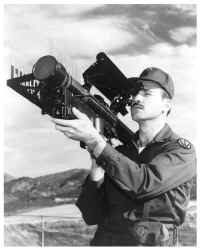
|

|
STINGER / AVENGER


|
The U.S. Army's shoulder-fired STINGER Weapon System provides effective, short-range air defense capabilities to soldiers and U.S. Marine Corps (USMC), U.S. Navy (USN), and U.S. Air Force (USAF) ground personnel who defend against low-level fixed and rotary-wing aircraft attack. It is the weapon of choice for the United States and many allied armed forces. The 35-pound, supersonic, fire-and-forget STINGER, which replaced the REDEYE, features quick-reaction acquisition and tracking, and all-aspect engagement, including head-on. Improved missile speed, range, maneuverability, flight tracking, and countermeasures rejection made the individual combat air defender using the STINGER the equal of the most sophisticated threat aircraft. Three variants, Basic STINGER, STINGER-Passive Optical Seeker Technique (POST), and STINGER-Reprogrammable Microprocessor (RMP) were developed. All operate in a similar fashion; are fielded as certified rounds in a disposable, sealed launch tube; and require no field testing or maintenance. All three use the rolling airframe concept, proportional navigation, passive homing, separate launch motor, dual-thrust flight motor, penetrating hit-to-kill warhead, reusable launcher/ gripstock, and belt-pack Identification, friend or foe (IFF) transceiver. The Basic STINGER is an infrared (IR) reticle-scan analog system using discrete component signal processing. The STINGER-POST employs an IR/ultraviolet (UV) dual detector, rosette-pattern image scanning, and digital microprocessor-based signal processing. Advanced features include improved acquisition, false target rejection, and additional countermeasures capabilities. The STINGER-RMP adds additional microprocessor power and is highly countermeasures resistant. New external software reprogrammability allows upgrades without costly retrofit as the threat evolves. The U.S. Army uses the STINGER-RMP not only for ground forces but to arm helicopters for air-to-air combat (Air-to-Air STINGER) and on the Bradley Fighting Vehicle (BFV) to provide low altitude air defense. Many allied countries have selected the export version of the STINGER-RMP (less reprogrammable module) for their armed forces, and two European coproduction programs for the export version were implemented. Early in the 1980s the U.S. Army began to research ways to overcome the military's lack of air defense. One result of these initiatives was the AVENGER weapon system. The AVENGER is a non-developmental item (NDI), lightweight, highly mobile and transportable surface-to-air missile/gun weapon system mounted on a high mobility multipurpose wheeled vehicle (HMMWV). Mounted on the turret are a .50 caliber M3P machine gun and two Standard Vehicle Missile Launchers (SVMLs), both of which contain four STINGER missiles. It is operated by a two-man crew for defense against helicopters and fixed wing aircraft at low altitude, day or night, and in clear or adverse weather. The system incorporates an operator's position with controls, displays, fire control electronics, and the SVML. The latter includes the seeker coolant bottles and related hardware, and it supports and launches multiple STINGER missiles. The SVML provides output signals that can be used to display to the gunner exactly where the STINGER missile is pointed. The drive sight reticle capability aids the gunner in severe background clutter and electromagnetic countermeasures (ECM) environments. The system operates with standard, unmodified Basic STINGER, STINGER-POST, or STINGER-RMP missile rounds. AVENGER filled the Line of Sight-Rear (LOS-R) role in Forward Area Air Defense Systems (FAADS). |
System Chronology
|
July 1965 An in-house research effort was started at Redstone Arsenal from which evolved the automatic infrared (IR) command guidance concept on which the tube-launched, optically-tracked, wire-guided (TOW)/Heavy Antitank Weapon (HAW) system was based. 1967 REDEYE II began advanced development. 1 July 68 The urgent need for development of an advanced manportable weapon was expressed and documented in the Technical Review of Army Air Defense Systems Study approved by DA on this date. 29 January 69 The Office, Chief of Research and Development (R&D) gave the Manportable Air Defense System (MANPADS)/REDEYE II effort priority I in the Advanced Forward Area Air Defense System. 29 January 70 DA approved a Qualitative Materiel Development Objective which outlined the requirement for a follow-on system to the basic REDEYE. Previously, such a system had been designated as the highest priority item in low altitude air defense. December 70 General Dynamics completed the fifth and final phase of the Advanced Sensor Development Program. 1971 The REDEYE II was selected for development as a replacement for the basic REDEYE. 16-17 February 71 During a special MANPADS in-process review held at MICOM, the REDEYE II weapon was evaluated in competition with six other systems. The review resulted in a recommendation that the REDEYE II with IFF and night vision devices begin development immediately as a replacement for the basic REDEYE system. April 71 A special REDEYE II Task Team was formed at MICOM to carry out required system planning and to develop and coordinate initial program documents. 18-19 August 71 The REDEYE II System Development Plan in-process review was held at MICOM. Development plans for the REDEYE II system were approved. 17 September 71 The Assistant Secretary of the Army (R&D) signed the Determination and Findings for the REDEYE II engineering development with sole source procurement from General Dynamic's Electro-Dynamics Division, Pomona, California. 8 October 71 MICOM established the XFIM-92A (REDEYE II) Management Office (Provisional) to direct and control work on this new system. 5 January 72 The AMC Project Manager for REDEYE II was created at MICOM effective this date. 10 March 72 The REDEYE II was redesignated as STINGER. The Office of the Assistant Secretary of Defense affirmed the official popular name for the system on this date. The STINGER would replace the basic REDEYE on a one-for-one basis. 16 May 72 DA approved the materiel need for STINGER. 27 June 72 The contract for engineering development of the STINGER system was awarded to General Dynamics. March 73 Engineering design tests of the STINGER began. November 73 The STINGER guided flight test program began. Testing was halted in April 74 and again in August 74 to identify and resolve technical problems. 7 February 74 DA approved the "Stingthrift" program which would decrease the unit cost of the STINGER missile during production. Stingthrift was the first major program initiated by a MICOM contractor to implement the policies of the 1971 DOD Directive on Acquisition of Major Defense Systems. To achieve cost reduction during STINGER production, the engineering development program cost estimate was increased and the engineering design phase of the program was extended to incorporate planned design changes. August 74 The STINGER PM established a Red Team to conduct a technical evaluation of the STINGER. A proposed solution to the problems encountered during flight testing was verified during a test on 29 January 75. Resolution of these problems caused a 6-month slippage in the program schedule. FY 75 The Stingthrift design changes were incorporated into the flight test program during the year. These changes, designed to reduce cost during production, involved removing several components from the missile and launch tube and placing them on a separable gripstock. The latter item could then be placed on another launch tube after being removed from an expended launch tube, which would be thrown away after launch. February 75 A STINGER guided test vehicle scored a direct hit against a long-range, 400-knot target. March 75 The accuracy of the STINGER's target adaptive guidance was demonstrated against a maneuvering target for the first time when a guided test vehicle made a direct hit on a jet target while performing a 4g up maneuver. 1 May 76 The STINGER Project Manager (PM) became responsible for managing the POST advanced development. 1 July 76 MICOM issued a letter modification to General Dynamics providing for continuation of the POST advanced development. The contractor would redesign the seeker head to increase its sensitivity to meet the STINGER performance requirements and incorporate the changes necessary to meet all STINGER environmental conditions. 17 July 75 The first STINGER missile fired in the design flight test series was the first STINGER ever fired from a man's shoulder. This launch against a QT-33 target employing tactical countermeasures resulted in the physical intercept and destruction of the target. 28 July 75 The guided test vehicle flight test series was completed. During this test phase, STINGER demonstrated a capability against point source and plume targets (jet aircraft), performing maneuvers and employing tactical countermeasures. It also engaged high speed, direct oncoming targets. May-June 76 U.S. and German personnel conducted joint STINGER acquisition and tracking tests at the Meppen Test Center, Germany. These tests provided data on the operational effectiveness of the STINGER in the European environment. 28 June 77 The STINGER-POST program transitioned from advanced development to engineering development, when General Dynamics received a cost-plus-incentive-fee contract for the effort. July 77 The STINGER Production Qualification Test-Government (PQT-G), which began in April 76, was completed during the month. The overall PQT-G test results verified the engineering design of the STINGER weapon system and its capabilities. November 77 The STINGER system was type classified Standard (LCC-A). December 77 The baseline design for the STINGER-POST was changed to incorporate microprocessor-controlled signal processing. 20 April 78 The initial production contract for STINGER missiles was awarded to General Dynamics, Pomona Division. 1978-79 Because of the user community's concern about the lack of self-protection for attack and scout helicopters operating near the forward edge of the battle area, the MICOM Advanced Systems Concepts Office (ASCO) developed a concept for a Multipurpose Lightweight Missile System (MLMS) using the STINGER missile. January 79 Germany completed its system selection process, choosing the STINGER over the United Kingdom's BLOWPIPE and the Swedish RB-70 systems. 22 June 79 The Under Secretary of Defense for R&D was briefed on the MLMS concept, after which he directed the Army to establish the program in the FY 1981-85 Program Objectives Memorandum. August 79 MICOM transferred the MLMS program from ASCO to the STINGER Project Management Office (PMO). FY 80 The first approved foreign materiel sales (FMS) cases for the STINGER were received when Germany signed three FMS cases totaling $1.8 million for test hardware, technical training, and technical assistance. FY 80 The STINGER-POST In-depth Design Review Team, established in August 79, reported that the 48-month engineering development schedule was too optimistic and should be extended by 2 to 12 months. However, the team recommended that the technical objectives of the program should not be compromised because of schedule demand. The preliminary performance assessment indicated that the STINGER-POST would achieve the required lethality in a benign environment. The STINGER-POST engineering development schedule was extended subsequently to a predicted minimum of 54 months. August 80 Because of funding concerns, DARCOM and MICOM decided to defer start of the MLMS program. Despite user support for the MLMS, the MICOM Commander could not consider any major MICOM commitment to MLMS until technical and contractual problems with the basic STINGER were resolved. 30 September 80 MICOM and the U.S. Army Communications and Electronics Materiel Readiness Command (CERCOM) signed documents transitioning procurement responsibility for the IFF interrogator and programmer from MICOM to CERCOM, since these items fell within the latter's assigned mission. 21 November 80 The MICOM Commander approved the full release of the STINGER training and training support equipment. FY 81 Seven NATO countries—Germany, the Netherlands, Belgium, Norway, Greece, Turkey, and Italy—formed a STINGER Project Group. The European group requested a letter of offer for the STINGER technical data package (TDP), the first step toward establishing a coproduction program. 4 February 81 The MICOM Commander approved the full release of STINGER tactical equipment. 27 February 81 The basic STINGER weapon system achieved its initial operational capability (IOC) when the first STINGER section (six teams) in Europe received tactical hardware and could perform combat missions in the field. March 81 DA and DARCOM approved MICOM's request to restructure the STINGER-POST engineering development program from 54 to 60 months. Because of continuing technical problems, MICOM extended the program to 63 months. July 81 The U.S.-German memorandum of understanding (MOU) for European coproduction of the STINGER was submitted to DA for review. September-October 81 To obtain data for determining the air-to-air STINGER's (ATAS's) capability to engage helicopters flying in a nap-of-the-earth environment, DA directed that a concept evaluation program be conducted. The two-phase program consisted of controlled tests to measure system capability and free play exercises to determine system utility. The test results conclusively demonstrated the STINGER's suitability as an air-to-air self-protection system for helicopters. FY 82 Japan became the first allied nation to purchase the STINGER weapon system. FY 82 German tests of STINGER's suitability for use on board ships were completed during the year, with STINGER being certified as suitable for use on naval vessels. 27-28 April 82 MICOM conducted technical feasibility demonstrations at McGregor Range, Fort Bliss, Texas, in which unmodified Basic STINGER missiles were fired from the M55 multiround STINGER launcher (MUSL) test bed. The firing on 28 April represented a significant milestone since it was the first night launch of a STINGER missile. June 82 Tactical troops from the U.S. Army, Europe (USAREUR) successfully fired STINGER for the first time in a field setting. June 82 DA approved a required operational capability (ROC) document for ATAS to be installed on all-weather, day-night aircraft developed under the Army Helicopter Improvement Program (AHIP). FY 83 In its evaluation of candidates for the interim lightweight air defense system (I-LADS), the Army Air Defense Artillery Center found that the STINGER, augmented by a gun, was consistently the most effective system. These results convinced the center to change its requirements for LADS from a 40mm gun to a generic system, allowing a STINGER/gun hybrid to compete as the ultimate LADS. FY 83 In an effort to capitalize on the effectiveness of a hybrid STINGER/gun system while achieving the lightweight advantages desired in the LADS, the MICOM Research, Development & Engineering Center (RDEC) began developing a hybrid STINGER/ hypervelocity rocket system called the SETTER. The SETTER would be a palletized system, mounted on the bed of an unmodified HMMWV, and would use a remote fire control console. A joint MICOM/U.S. Army Tank-Automotive Command (TACOM) venture, the SETTER would be capable of multiple target acquisition with both the guided STINGER missile and unguided munitions. FY 83 AMC tasked MICOM to develop a comprehensive plan to ensure the commonality of missiles and launcher hardware for STINGER derivations, including the ATAS, SERGEANT YORK, Pedestal Mounted STINGER (PMS), and PIVADS Hybrid. 27 April 83 The United States and the Federal Republic of Germany signed an MOU for dual production of the Basic STINGER and STINGER-POST weapon systems. A STINGER Dual Production Support Office was established at Koblenz, Germany. June 83 Switzerland expressed an interest in joining the European/American dual production program. The member nations approved Switzerland's participation, but the Swiss made no commitment during this year. 6 June 83 The Army Systems Acquisition Review Council (ASARC) decision on STINGER-POST production was to enter production with a concurrent RMP configuration development, which would be delivered at the completion of production transition. The RMP would expand the functional control of microprocessors in the electronics and permit the reprogramming of the system logic through an externally accessible program module. 27 July 83 Initiation of STINGER-POST production was approved on this date pending resolution of the RMP funding issues. August 83 The MOU between MICOM, the U.S. Army Aviation Research and Development Command (AVRADCOM), and the U.S. Army Troop Support and Aviation Materiel Readiness Command (TSARCOM) concerning the MLMS was completed during the month. The MLMS was actually a two-missile concept: one missile to be developed for an air-to-air role and the other for an air defense suppression role. Because there were different operational capability dates for the two concepts, this MOU applied only to the air-to-air missile. The MOU defined each command's respective roles and responsibilities in the ATAS program. September 83 A joint evaluation of the unsolicited proposal submitted by General Dynamics and Bell Helicopter Textron, Incorporated, for engineering development of the air-to-air MLMS culminated in a decision to accept the contractors' proposal but only with some technical modifications. 1 September 83 The Missile Command awarded General Dynamics a low-rate initial production transition contract for the STINGER-POST. 6 September 83 A successful IOC for the STINGER weapon system in Korea was achieved. 19 September 83 Under a separate MOU signed on this date, Germany acted as the licensee for a consortium of NATO nations interested in some kind of joint partnership for producing the STINGER and STINGER-POST. The nations included in the partnership were the Netherlands, Belgium, Greece, Turkey, and Italy. A separate STINGER Project Group MOU with these countries was signed because Germany had agreed that STINGER hardware could be sold or transferred only to NATO countries with which it had a separate MOU. 21 September 83 Boeing Aerospace Company presented a modified, unsolicited proposal to the Army Development and Employment Agency for an AVENGER prototype demonstration in April 84. The AVENGER was being studied as a possible candidate for the 9th Infantry Division's (ID's) need for a HMMWV-mounted STINGER. The prototype would consist of four ATAS launchers turret-mounted on the back of a HMMWV. October 83 The fielding of STINGER under combat conditions occurred during the U.S. airborne assault on Grenada. The deployment of 27 STINGER teams against Cuban and local forces on the Caribbean island provided a valuable learning experience for both the paratroopers and the chain of command. Questions about the system's manportability as well as other needs were raised by the assault. 27 October 83 The U.S. Army Air Defense Board completed an evaluation of the U.S. Army Armament Research and Development Center (ARDC) air defense gun/missile experiment known as ADGILE. The prototype of the hybrid system consisted of a 25mm GAU-12/U cannon and an engineering ATAS launcher. The experiment clearly demonstrated the feasibility of an integrated STINGER/gun hybrid system. December 83 At DARCOM's direction, MICOM conducted feasibility tests of a STINGER jump pack in support of requirements expressed by the 82d Airborne and the Rangers. These tests indicated that foam cushioned packs would provide protection for the weapon during jumps. The Natick Research and Development Laboratories subsequently tested prototypes of the proposed jump packs and determined that the pack was too large for safe exit of the C-130 aircraft as well as larger than the exit passage from the C-141 aircraft. As a result, the 82d Airborne's interest in the pack ended, but that of the Rangers continued. FY 84 The first delivery of STINGER missiles to the National Guard went to the 5th Battalion ROLAND of the 20th Air Defense Artillery (ADA) at White Sands, New Mexico. FY 84 Initial delivery of STINGER training and support equipment to the USAF was made during the year. This equipment went to Korea. The Air Force planned to deploy STINGER with little or no duplication of Army efforts. 5 January 84 After Army intelligence data continued to reinforce the threat assessment justifying development of the STINGER-RMP, the Under Secretary of the Army directed that the RMP engineering development program be initiated. He also agreed to justify the reprogramming of funds with the House Armed Services Committee, which did not accept the threat assessment and believed the RMP to be a high technical risk. March 84 MICOM awarded General Dynamics a contract for the last buy of Basic STINGER missiles for U.S. forces. March 84 The German government sent European industry a request for proposal for production of the STINGER weapon system in Europe. Initial analysis of the proposals submitted by Messerschmitt Boelkow Blohm/Bodenseewerk Geratetechnik and Dornier/Diehl indicated that production in Europe was feasible. March 84 After DARCOM approved the ATAS engineering development acquisition, contract negotiations began during this month. Before year's end, the U.S. Army Aviation Systems Command (AVSCOM), overall manager for the MLMS weapon subsystem, signed contracts with General Dynamics and Bell Helicopter Textron, Incorporated, for full-scale development of the ATAS. 17-19 May 84 Three demonstration firings of the AVENGER system at Yakima Firing Range, Washington, resulted in two direct hits and one tactical hit on a ballistic aerial target system. In these initial evaluations, the AVENGER met or exceeded performance requirements specified in a Quick Reaction Plan which called for a pedestal-mounted STINGER system as a one-for-one replacement for half of the 9th ID's MANPADS teams. 13 June 84 The Under Secretary of the Army directed DA to obtain the reprogramming of necessary funds and start the RMP program as soon as possible. July 84 After MICOM held several meetings with the SERGEANT YORK Project Office on the possible addition of the STINGER to the SERGEANT YORK system, the latter PM briefed the Secretary of Defense on the proposed addition. 20 September 84 Congress approved funds for the STINGER-RMP engineering development program, and a letter contract was issued to General Dynamics less than a week later. October 84 MICOM supported the USAF in its demonstration of another mobile weapon system (MWS), consisting of an ATAS launcher and a 30mm GAU-13 cannon mounted on a light armored vehicle, by negotiating a lease agreement with General Dynamics for prototype ATAS launchers for use on the MWS. During the firing demonstration conducted at the end of the test, both of the STINGER missiles fired scored direct hits against unaugmented QH-50 drone helicopters. October 84 Boeing submitted an unsolicited proposal for 51 AVENGERS to MICOM after 9th ID successfully fired STINGER missiles from the unit in May 84. December 84 The results of a report by a data gathering team which visited Fort Bragg, North Carolina, and Fort Bliss, Texas, as part of the fielded system review process for STINGER, were published. The STINGER weapon was one of the first systems to undergo the comprehensive review required by DARCOM Regulation 702-13. The review assessed all aspects of the STINGER, including logistic support, user satisfaction, and possible improvements. Review results indicated that STINGER had been well received by the user community. FY 85 STINGER production passed the 10,000th missile mark. February 85 The USMC evaluated their Light Armored Vehicle-Air Defense System at Eglin Air Force Base (AFB), Florida, using a 25mm GAU-12 cannon and an ATAS launcher. Three STINGER launches, including one stationary flight and two shoot-on-the-move, resulted in direct hits on QH-50 drone helicopters and a one-seventh scale remotely piloted vehicle (RPV). January 85 Although AMC initially instructed MICOM to proceed with the procurement of the AVENGER system from Boeing, the command informed the contractor during this month that its unsolicited proposal of October 84 could not be accepted because of the lack of requirements or funding for the system in FY 85. March 85 A market survey, undertaken after DA and AMC required the STINGER Project Office to develop various preliminary approaches to procure a PMS as an NDI, identified the SETTER as a potential candidate in addition to Boeing's AVENGER. April 85 Dornier, a German defense contractor, was selected as the prime contractor for the STINGER dual production program in Europe. 30 May 85 AMC directed that operational suitability tests of the SETTER be conducted and an acquisition strategy be developed, based on a candidate test and evaluation competition to determine whether the AVENGER or SETTER would best meet the Army's PMS requirements. June 85 Belgium, one of the original European STINGER Production Group members, withdrew from the consortium after deciding to acquire the French MISTRAL system instead. 25 June 85 DA approved an expedited essential ROC document for the PMS. 22 July 85 AVSCOM and MICOM signed a final MOU which addressed all of the ATAS issues over which the two commands differed, after the STINGER PM protested AVSCOM's decision to retain Contracting Officer's Technical Representative (COTR) authority for the ATAS launcher, electronics interface, and other STINGER related hardware. The new agreement delegated COTR authority for the launcher and interface electronics to the STINGER PM, enabling his office to comply with earlier AMC guidance that the office ensure the commonality of missiles and launcher hardware for STINGER derivations. 27 August 85 The program to put the STINGER on the SERGEANT YORK ended after the Secretary of Defense terminated the latter project on this date. 10 October 85 The SETTER system began operational suitability tests at Yakima, Washington. 8 November 85 MICOM modified the FY 85 STINGER-POST production contract, originally awarded to General Dynamics in August 85, to require delivery of STINGER-RMP configured hardware instead of STINGER-POST. 18 March 86 The Office of the Secretary of Defense (OSD) directed the STINGER Project Office to procure and deploy a HMMWV mounted version of the STINGER missile system as a replacement to the MANPADS configuration. 26 March 86 The United States and Germany signed amendment I to the 1983 dual production MOU allowing European production of the STINGER-RMP, less the external module to reprogram the missile. The implementing arrangement was signed the following day. April 86 The STINGER-POST TDP was transferred via FMS to the European STINGER Production Group. 17 July 86 MICOM issued a request for proposal for the PMS. September 86 The first five production STINGER-POST missiles were delivered on schedule. 30 September 86 The first article/initial production flight test program for the STINGER-POST began at White Sands Missile Range (WSMR). The first production missile, fired against an MQM-107 (subscale) drone employing specification rate countermeasures, resulted in a direct hit. 17 September 86 Three contractors—Boeing Aerospace, LTV, and General Dynamics—submitted proposals for candidate PMS systems. November 86 Technical and operational tests and evaluations of the three candidate PMS systems began during this month. 12 December 86 The requirement for the AVENGER was first outlined in the FAADS Capstone/ROC. May 87 Italy formally announced its withdrawal from the European STINGER dual production program. The effective date of this withdrawal was 30 June 87. June 87 Delivery was made of the last Basic STINGER missiles in support of an FMS case with Italy. Basic STINGER production was completed. July 87 Testing and evaluation of the three candidate PMS systems was completed. August 87 MICOM awarded the first production contract for ATAS launchers. 24 August 87 Boeing Aerospace Corporation was awarded a contract for production of its AVENGER/PMS weapon system. 17 September 87 The MICOM Commander approved the full materiel release of the STINGER-POST. 25 February 88 The Swiss MOU for coproduction of the STINGER-RMP (less reprogrammable module) was signed. 26 April 88 The consortium MOU for the European production of the STINGER weapon system was signed by all the member nations, subject to ratification by their respective parliaments. The MOU was ratified by Germany, the Netherlands, and Turkey before year's end. 27 September 88 The partial production contract with Dornier, the prime contractor for the European STINGER dual production program, was signed. 20 October 88 The ATAS TDP was released to government control. 1 November 88 The rollout ceremony for the first two AVENGER fire units was conducted at the Huntsville Boeing Aerospace facility. FY 89 DA formally approved a name change from Pedestal Mounted STINGER to AVENGER during the year. 30 January 89 Greek parliamentary approval of the European consortium MOU for the production of the STINGER weapon system occurred. This was the last country to ratify the MOU. 25 April 89 The contract was signed with Dornier for European production of the STINGER. 29 April 89 The 3d Armored Cavalry Regiment was the first unit equipped (FUE) with AVENGER. July 89 The first STINGER-RMP missiles were delivered. 23 October 89 The Swiss coproduction contract with the prime contractor was signed. November 89 MICOM's RDEC concluded a Performance Estimate which indicated that the STINGER system with the Modification III Revision 13 software met the U.S. Army's current need. Based on STINGER-RMP testing with the Modification III Revision 13 Module and default (less module), DA initiated a limited material release to the field. 30 November 89 The Implementing Agreement to the U.S.-Swiss MOU for STINGER coproduction was signed. December 89 AVENGER Production Qualification Testing (PQT) was completed. AVENGER was the only air defense system to successfully complete all environmental testing and a grueling 1500-hours reliability demonstration. FY 90 Israel was the first FMS nation to receive STINGER-RMP (less reprogrammable module) missiles and training/support equipment. 9 February 90 The AVENGER was type classified Standard. 12 April 90 The Defense Acquisition Board (DAB) granted the AVENGER program authority to proceed to full-scale production (FSP). July 90 Amendment 1 to the European STINGER dual production program production contract between Dornier and BWB was signed, authorizing production of the STINGER-RMP (less reprogrammable module) weapon system. August 90 AVENGER Total Package Fielding (TPF) began on schedule to the 4th Battalion/5th ADA, 1st Cavalry Division (1CD) at Fort Hood, Texas. The beginning of Operation Desert Shield/Storm (ODS) and the alert of 1CD for deployment to Southwest Asia (SWA) caused AVENGER fielding to be accelerated. September 90 After three platoons were trained and equipment was handed off in 5 weeks, the 1CD deployed to SWA. November 90 To support ODS, the contractor accelerated delivery of the Modification IV software, the latest upgrade programmed into the externally accessible module in the gripstock. The contractor delivered about 2,000 modules in the November-December time frame to fill requirements for the U.S. Army, USN, and USMC. Another 1,200 modules were completed by February 91. November 90 Three AVENGER fire units were fielded to the U.S. Army Ordnance Missile and Munitions Center and School (OMMCS), Redstone Arsenal, Alabama, to further establish the training base for AVENGER maintenance. November 90 After testing ended this month, integration of the STINGER on the COBRA helicopter was essentially completed. FY 91 The Army terminated procurement of the STINGER-RMP missile for FY 92-96 based on affordability issues and acceptable risk. The Army Acquisition Executive (AAE) approved a new Acquisition Program Baseline on 4 February 91. FY 91 Deployment of the AVENGER to Korea was delayed due to ODS priorities. 3 May 91 The AAE approved the restructuring of the Air Defense Program Executive Office (PEO), which affected the STINGER Project Office (PO) by splitting it in to two separate organizations: the Air-to-Air Missile (ATAM) PO and the AVENGER PO. 1 July 91 The STINGER PO was redesignated the ATAM PO. The new name reflected a shift in focus from ground-launched missiles to air-to-air. October 91 Retrograde/retrofit of STINGER assets from SWA to Red River Army Depot (RRAD) began. An extensive cleanup and refurbishment effort was required after the missiles' 6 to 8 months of daily exposure to harsh desert conditions. FY 92 Three units in Germany with ATAS equipment—the 2d Armored Cavalry Regiment, Nuremberg; 5/6 Aviation Regiment, Wiesbaden; and 3/3 Aviation Regiment, Giebelstadt—were inactivated due to the drawdown of U.S. forces in Europe. Aircraft from these units were redistributed to other aviation units. FY 92 Three Bradley STINGER Fighting Vehicles (BSFVs) were fielded to heavy divisions and the U.S. Army Training and Doctrine Command (TRADOC) during the year. The BSFV was an interim solution to the void left by cancellation of the Air Defense Antitank System (ADATS). The BSFV consisted of a standard BFV with racks mounted inside to hold STINGER weapon rounds and MANPADS teams to fire them. FY 92 During the first quarter, a system specification was developed for an Institutional Conduct of Fire Trainer (ICOFT). Design and development of an initial ICOFT also started. The ICOFT's main purpose was to train and develop AVENGER gunner skills in the search, acquisition, and engagement of hostile aircraft. January 92 Fielding of the OH-58D KIOWA WARRIOR aircraft equipped with ATAS began. Deployment of the OH-58C KIOWA aircraft equipped with ATAS continued. 10 February 92 The AVENGER PO was chartered. April 92 STINGER-RMP FUE was successfully accomplished with the fielding to U.S. Army Pacific (Hawaii). 21 April 92 A letter contract was awarded to start Block I development, a product improvement program (PIP) to increase STINGER's countermeasures capability via externally loaded software downloaded from a reprogrammable module in the gripstock. Block I added a roll sensor and enhanced software, solved the recognition system deficiency in countermeasures and other engagement conditions, and increased terminal accuracy. The planned Block II (Advance STINGER) development would add a new infrared focal plane array which would improve performance in clutter. May 92 STINGER prime contractor General Dynamics Corporation announced it was selling its missile business to Hughes Aircraft Company (HAC). The sale was completed in August 92. HAC consolidated the former General Dynamics missile units with its own missile operations to form a new subsidiary, Hughes Missile Systems Company. June 92 The AVENGER PO began a reliability test program for the M3P .50 machine gun after it proved to be unreliable in dust and sand like that encountered during ODS. The gun failed the minimum acceptable requirement, so the manufacturer initiated an improvement program. June 92 The project office was alerted to the possibility that STINGER rounds deployed to SWA might be unsafe after being exposed to extremely high temperatures. Data from subsequent testing in SWA indicated that the deployed rounds were safe to use. 29 July 92 After the Air Defense PEO was deactivated on this date, ATAM was transferred to the newly created PEO, Tactical Missiles. The separate AVENGER Project Office was also transferred to the newly created organization. July-December 92 At the request of the XVIII Airborne Corps Commander, evaluation and testing were conducted to qualify the STINGER missile for airdrop missions while configured in the back of HMMWVs. Testing was completed in December with two successful airdrops. FY 93 A STINGER modification kit was developed and tested to provide interim air defense capability for the line of sight-forward-heavy (LOS-F-H) requirement. The kit adapted the interior of a Bradley armored vehicle for deployment of a STINGER team. Fielding of the kit began during this year. FY 93 Two ICOFT partial prototypes were fabricated. FY 93 A prototype environmental control unit/prime power unit (ECU/PPU) was delivered and began undergoing demonstration tests. The ECU/PPU was essential for soldier safety and corrected an ODS demonstrated deficiency. The new design, which would replace the interim ECU/PPU which began deliveries in FY 91, would provide cooling; at least 3 Kw of excess power for the turret electronics; and act as a filter for nuclear, biological, and chemical (NBC) contaminants. March 93 A requirement was identified for the refurbishment of STINGER Basic and RMP missiles returned from SWA. The rounds developed a significant rust and corrosion problem after being cleaned and temporarily stored in plywood containers at RRAD. May 93 Qualification testing for the prototype ECU/PPU began this month. Several failures were noted and documented during the environmental, vibration, human factors, safety, and simulated missile firing tests. 4 August 93 The Forward Area Air Defense (FAAD) Project Office was activated, reuniting the ATAM and AVENGER POs. The FAAD systems provided Army divisions, armored cavalry regiments, and separate brigades with dedicated air defense artillery. FAAD consisted of three ground-to-air components (STINGER MANPADS, AVENGER, and BSFV) and one air-to-air component (ATAS). September 93 The AVENGER successfully completed a static airdrop impact test (SAIT) at Natick Laboratories. This test validated the rigging design and simulated the vertical loads seen during the low velocity air drop (LVAD) performed by the 82d Airborne Corps. FY 94 The hardware development effort for the Block I STINGER was completed. August 94 AVENGER was certified for airdrop following its third successful test at Fort Bragg. FY 95 Plans were finalized for the transition of the AVENGER system from the PEO, Tactical Missiles to the MICOM Weapon Systems Management Directorate (WSMD), effective 1 October 95. 1 October 95 The FAAD Project Office was disestablished and the STINGER Product Office was established. |
STINGER Photos
 |
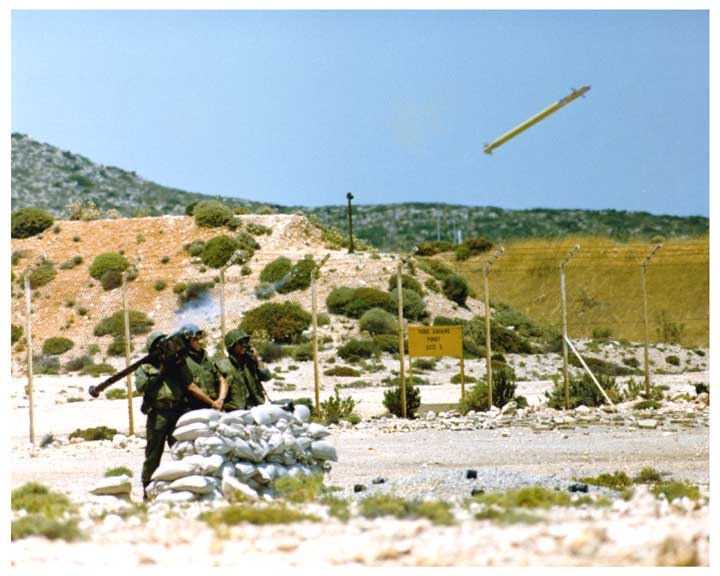 |
 |
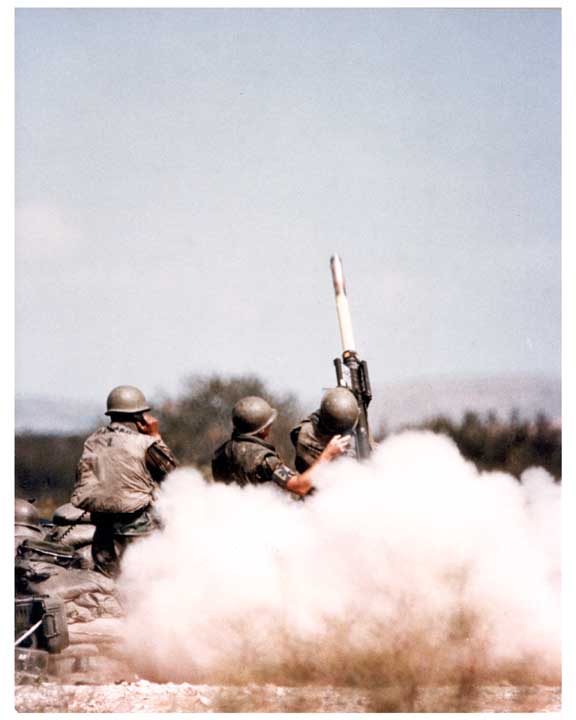 |
 |
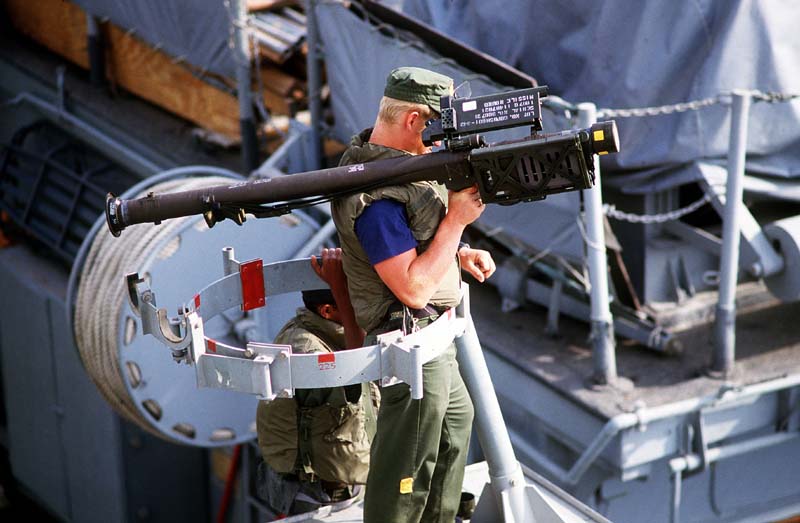 |
 |
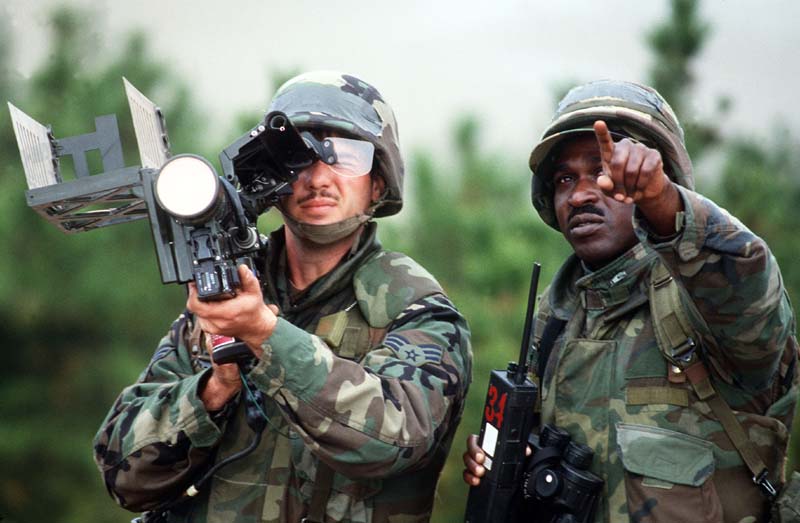 |
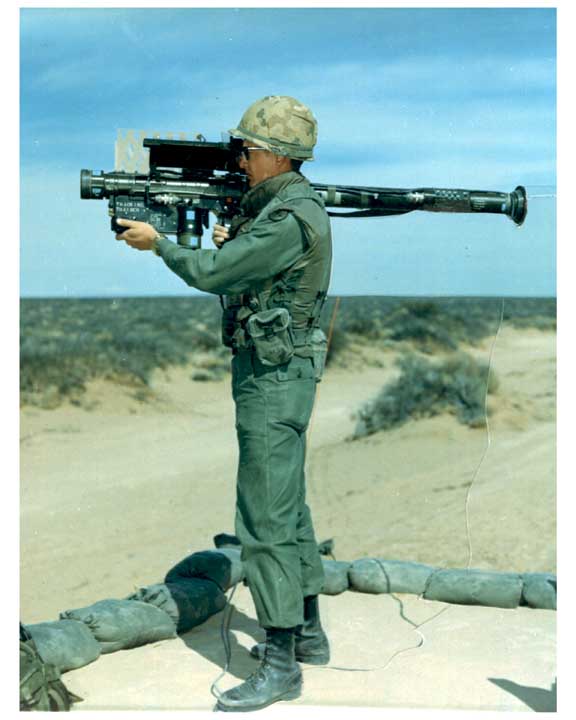 |
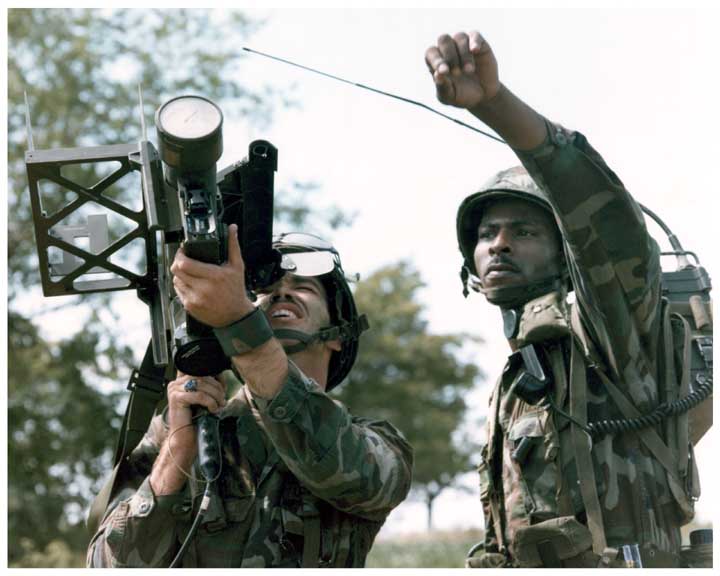 |
AVENGER Photos
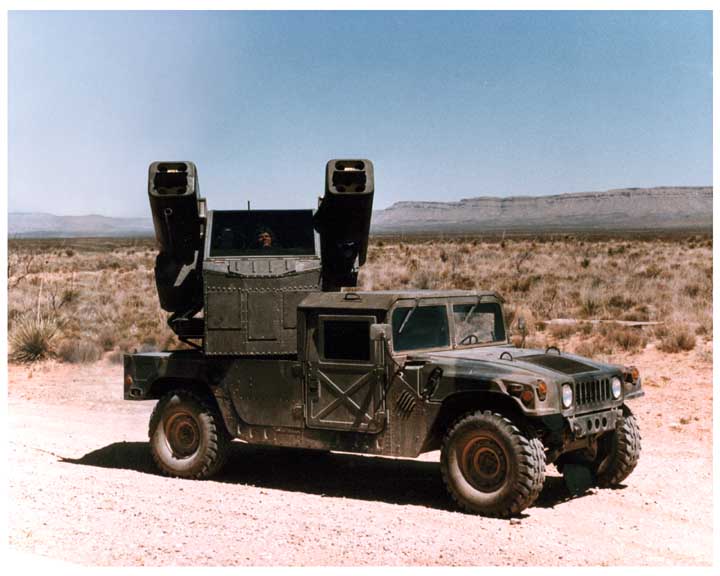 |
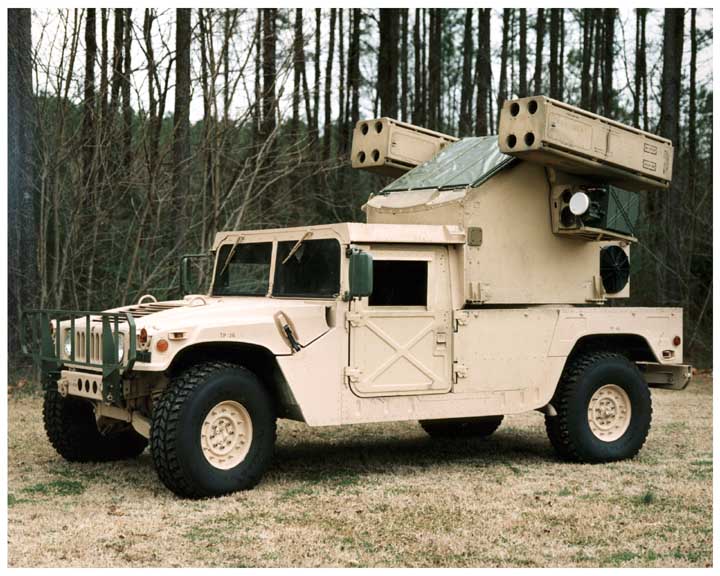 |
 |
 |
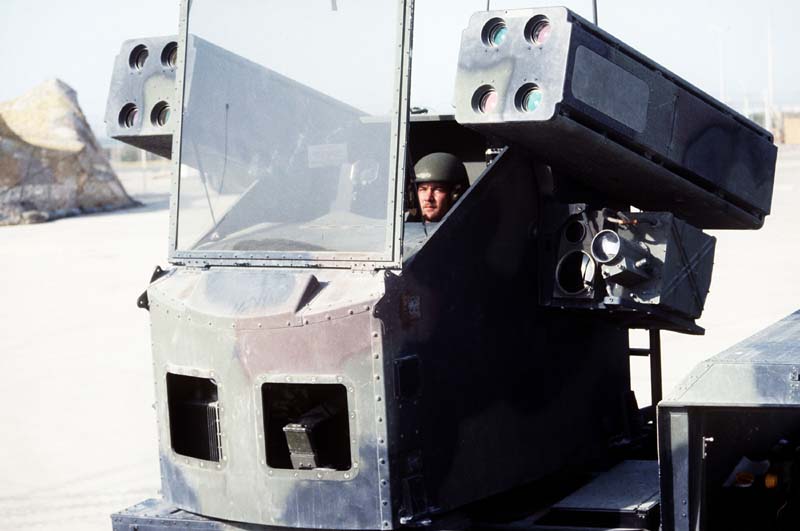 |
 |
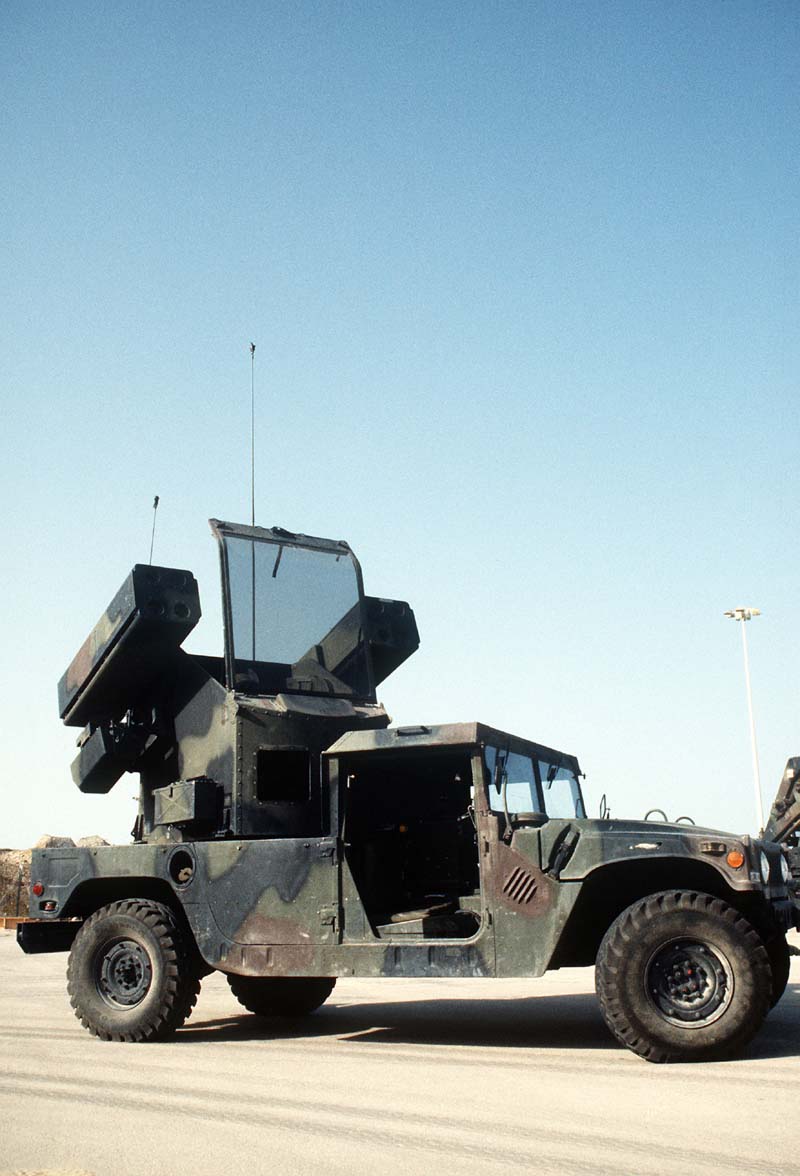 |
